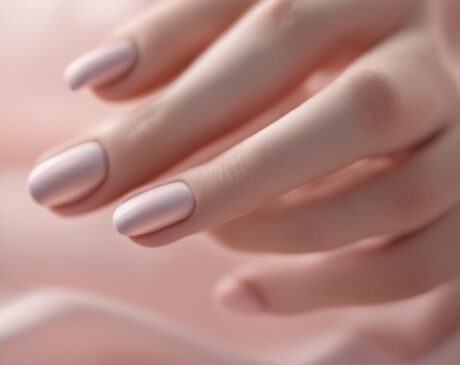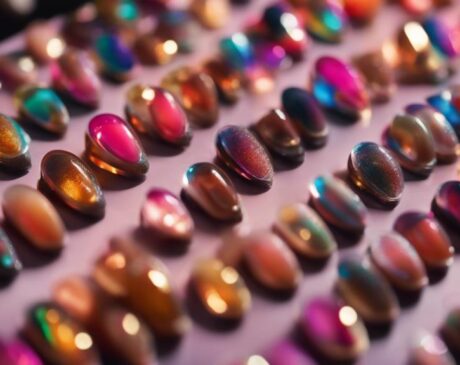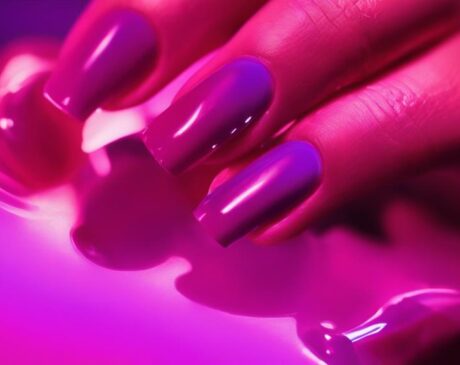How Damaging Is UV Light for Nails?
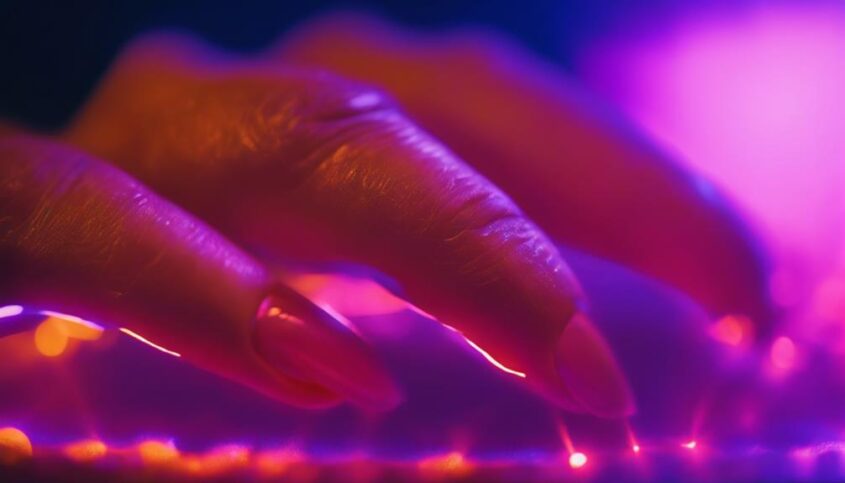
UV light exposure can damage nails, causing discoloration, dryness, and brittleness. Prolonged exposure poses risks of skin cancer and premature aging. Protective coatings and UV-blocking polishes can shield nails. Consider LED lamps for gel polish curing with lower UV levels. Air dry formulas and non-toxic nail wraps offer healthier alternatives.
Key Takeaways
- UV light exposure causes discoloration, dryness, and brittleness in nails.
- Prolonged UV exposure increases skin cancer risk on surrounding skin.
- UV radiation compromises nail structural integrity and promotes premature skin aging.
- UV light breaks down keratin in nails, leading to weakness and peeling.
- Protective measures like UV-blocking polish and gloves shield nails from UV damage.
Understanding UV Light and Nails
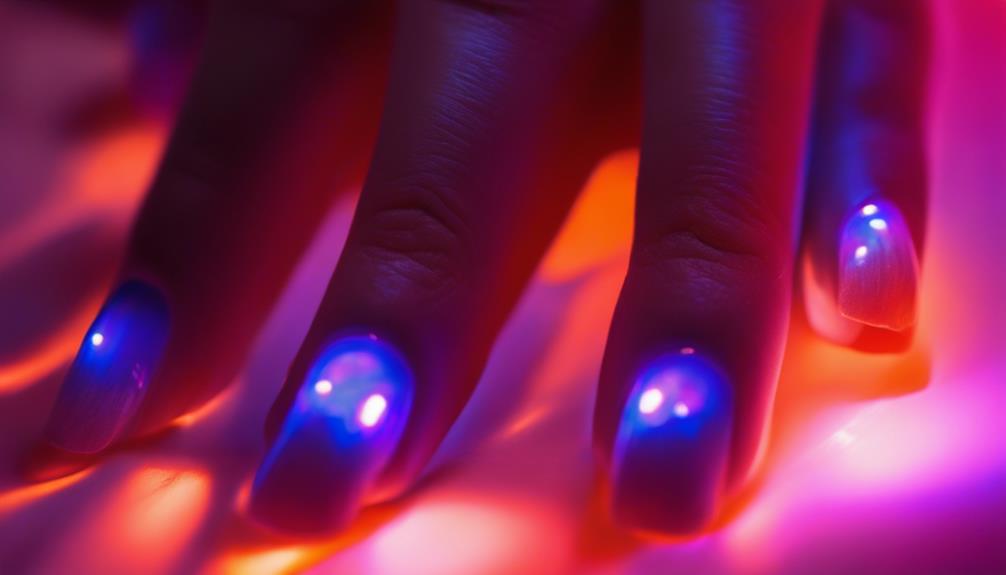
The interaction between UV light and nails is a topic that requires a comprehensive understanding to appreciate its effects. UV light, specifically in the form of UV lamps used in various nail treatments like gel manicures, can penetrate the nail plate to reach the nail bed. This process is crucial for the curing of gel polishes but raises concerns about potential long-term consequences on nail health.
UV light exposure can lead to the production of free radicals within the nail cells, causing oxidative stress and potential damage to the DNA and proteins in the nails. This damage may manifest as dryness, brittleness, yellowing, or even weakening of the nails over time. Understanding the depth of UV penetration and its impact on nail structure is essential for developing safer nail treatments that minimize these risks.
Researchers are exploring innovative ways to mitigate the negative effects of UV exposure on nails, such as developing UV-absorbing topcoats or alternative curing methods that reduce direct UV contact. By staying informed about the latest advancements in nail technology, professionals can offer treatments that prioritize both aesthetics and nail health.
Risks of UV Exposure on Nails
Excessive exposure to UV light can pose significant risks to the health and integrity of nails. UV radiation can lead to a range of issues, including discoloration, dryness, brittleness, and even an increased risk of developing skin cancer on the surrounding skin. The nails, being highly exposed during manicures or gel treatments, are particularly vulnerable to these potential harms. Innovation in nail care is essential to address these risks effectively.
Moreover, prolonged exposure to UV light can also result in premature aging of the skin around the nails, causing wrinkles, age spots, and loss of elasticity. This not only impacts the aesthetic appeal of the hands but also indicates underlying damage to the skin cells. As the beauty industry continues to evolve, it is imperative to explore alternative methods and technologies that can reduce UV exposure without compromising the efficacy of nail treatments. Prioritizing the health and safety of both nails and skin is crucial in achieving sustainable beauty practices.
Effects of UV Light on Nail Structure
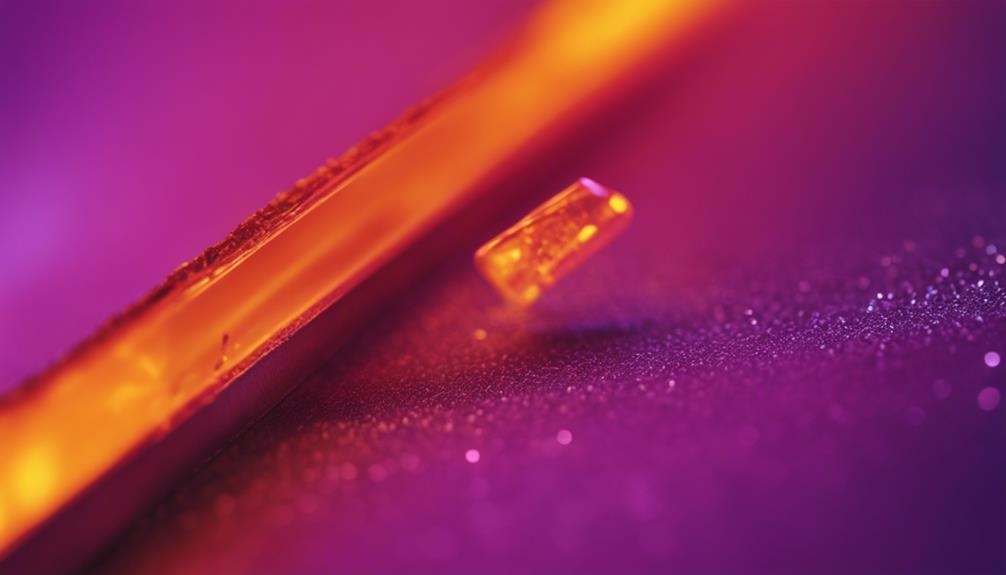
Prolonged exposure to UV light can compromise the structural integrity of nails, leading to various detrimental effects on their composition and overall health. The nail structure consists of keratin, a protein that gives nails their strength and flexibility. When nails are exposed to UV light for extended periods, the UV radiation can break down the keratin molecules. This breakdown weakens the nails, making them more prone to brittleness, splitting, and peeling.
Moreover, UV light exposure can also dehydrate the nails, stripping them of essential moisture. This dehydration can further exacerbate nail fragility and dullness. Additionally, UV radiation may alter the natural pigmentation of the nails, leading to discoloration or yellowing.
Innovations in nail care have introduced UV protective coatings and polishes that act as a barrier against harmful UV rays. Regular hydration and nourishment through cuticle oils and moisturizers can also help maintain the nail structure's health and resilience against UV-induced damage.
UV Nail Damage Prevention Tips
To shield nails from UV damage, applying protective nail coatings and using UV-blocking nail polish are essential prevention methods. These measures act as barriers, reducing the direct impact of UV light on the nail structure. By incorporating these protective strategies, individuals can help maintain the health and integrity of their nails when exposed to UV radiation.
Protective Nail Coatings
Protective nail coatings are an effective measure to prevent UV light damage to the nails. These innovative coatings act as a barrier, shielding the nails from the harmful effects of UV radiation. By applying a protective coating before exposing your nails to UV light, you can significantly reduce the risk of damage such as discoloration, brittleness, and dryness. These coatings are designed to provide a layer of protection without compromising the appearance or health of your nails. With advancements in nail care technology, protective coatings offer a simple yet powerful solution for safeguarding your nails against the damaging effects of UV light. Prioritizing the use of these coatings can help maintain the strength and vitality of your nails in the face of UV exposure.
Uv-Blocking Nail Polish
When seeking effective protection against UV light damage to nails, utilizing UV-blocking nail polish proves to be a practical and essential measure. UV-blocking nail polishes contain specific ingredients that act as a barrier, shielding the nails from harmful UV radiation. These innovative formulas offer a stylish solution to safeguarding the nails while maintaining a fashionable appearance. By applying UV-blocking nail polish, individuals can enjoy outdoor activities without compromising the health and integrity of their nails. This advanced technology not only provides protection but also ensures long-lasting wear and chip resistance. Incorporating UV-blocking nail polish into your beauty routine is a proactive step towards maintaining healthy and beautiful nails in the face of constant UV exposure.
UV Nail Drying Vs. Harmful Exposure
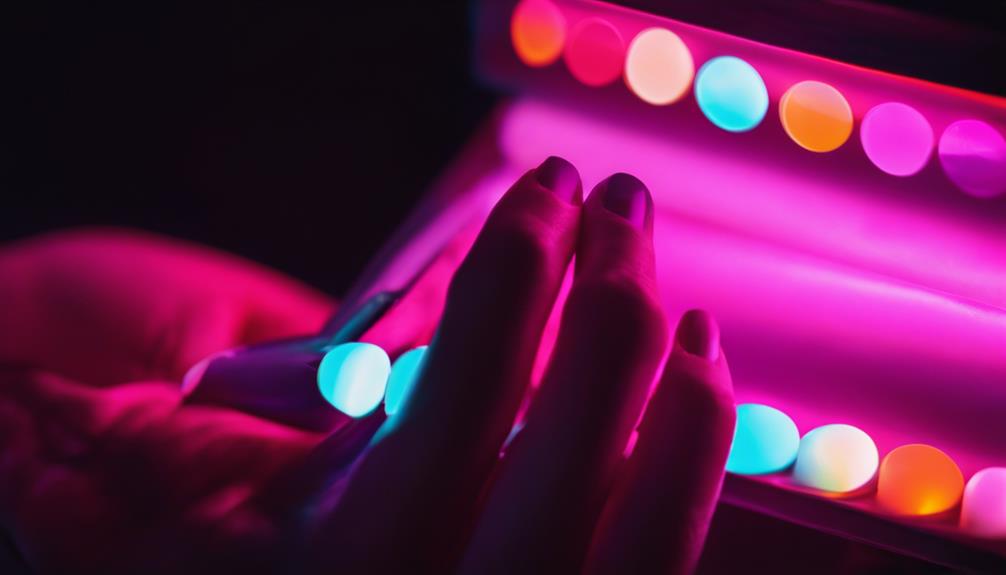
When considering UV nail drying versus harmful exposure, it's crucial to understand the balance between efficiency and potential risks to nail health. The process of UV drying can expedite the nail polish setting, but it also comes with the concern of prolonged exposure to harmful UV rays. To mitigate these risks, implementing protective measures such as using sunscreen or UV-blocking gloves can help safeguard against any potential damage to the nails and surrounding skin.
UV Drying Process
UV nail drying processes utilize ultraviolet light to cure and harden gel nail polish efficiently, although concerns persist regarding the potential harmful exposure associated with prolonged use. The UV drying process works by activating photoinitiators in the gel polish, causing it to polymerize and harden quickly under the UV light. While this method offers a fast and durable manicure, repeated exposure to UV light during nail drying sessions may increase the risk of skin damage and premature aging. To mitigate these risks, it is advisable to apply a broad-spectrum sunscreen to the hands before undergoing UV nail drying. Additionally, using LED lamps for curing gel polish is a safer alternative, as they emit lower levels of UV light and reduce the risk of potential harm.
Nail Health Risks
Given the concerns surrounding potential harmful exposure from UV nail drying processes, it is imperative to examine the comparative nail health risks associated with this method in contrast to other potential sources of harm. While UV nail drying offers efficiency and convenience, it also poses certain risks to nail health. To provide a clearer perspective, consider the following:
- UV Exposure: Continuous exposure to UV light during nail drying may lead to skin damage and premature aging.
- Chemical Sensitivities: Some individuals may experience adverse reactions to the chemicals present in gel polishes used alongside UV drying.
- Nail Weakness: Prolonged or frequent use of UV nail drying methods can contribute to nail weakness and brittleness.
These factors underline the importance of balancing innovation with caution in nail care practices.
Protective Measures
What strategies can be implemented to mitigate the potential risks associated with UV nail drying processes in order to safeguard nail health? As awareness of the potential harm from UV light exposure grows, innovative protective measures are being developed. One approach is the use of UV-blocking gloves or finger shields during the nail drying process. These accessories act as a barrier, reducing direct exposure to the harmful UV rays. Additionally, advancements in nail polish technology have led to the creation of UV-curable nail polishes that require less UV exposure during the drying process. Furthermore, utilizing LED lamps for nail drying is another effective protective measure, as they emit lower levels of UV light compared to traditional UV lamps. By adopting these protective measures, individuals can enjoy the benefits of UV nail drying while minimizing the associated risks to nail health.
UV-Free Alternatives for Nail Health
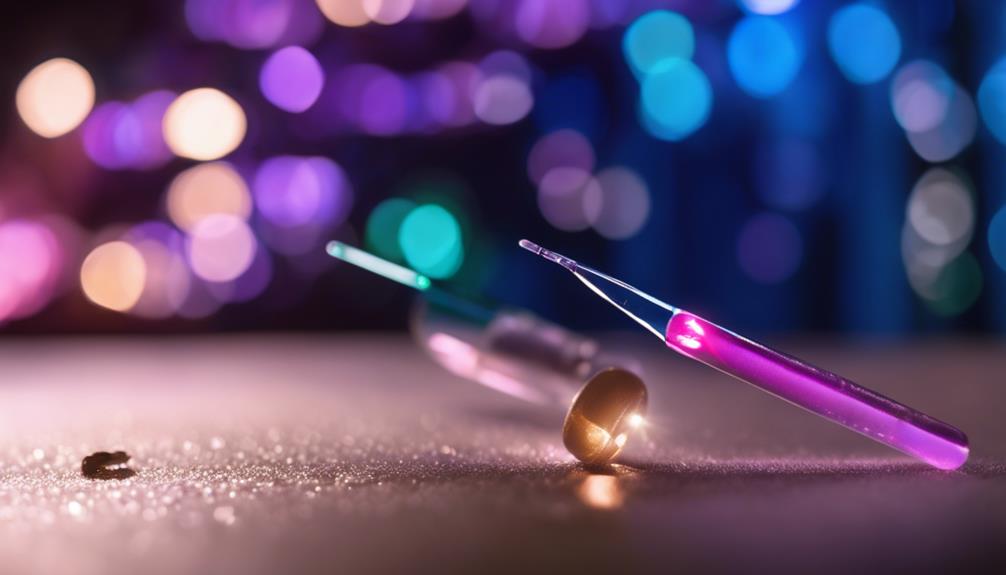
In the realm of nail care, seeking out non-UV alternatives is paramount for maintaining optimal nail health. As awareness grows regarding the potential risks associated with UV exposure during nail treatments, individuals are turning towards innovative solutions that prioritize nail well-being without compromising on aesthetics. Here are three UV-free alternatives that are revolutionizing the nail industry:
- LED Nail Lamps: Utilizing LED technology, these lamps cure gel polish efficiently without emitting harmful UV rays, providing a safer option for nail enthusiasts.
- Air Dry Formulas: Innovative nail polish formulas that dry quickly in the air, eliminating the need for UV or LED lamps altogether, promoting healthier nails.
- Non-Toxic Nail Wraps: These adhesive nail wraps offer a UV-free way to achieve intricate designs and colors without the use of potentially damaging UV light, safeguarding nail health while embracing creativity.
Frequently Asked Questions
Are All UV Nail Lamps Equally Damaging to Nails, or Are There Specific Types of Lamps That Are Less Harmful?
When considering UV nail lamps, it's crucial to differentiate between models as not all are equally damaging. Some lamps incorporate advanced technologies that minimize potential harm to nails, making them a safer choice for nail enhancements.
Can Wearing Nail Polish or Gel Polish Offer Any Protection Against UV Light Damage to the Nails?
Wearing nail polish or gel polish can provide minimal protection against UV light damage to the nails. While it may offer a slight barrier, it is not a substitute for proper UV protection measures such as using sunscreen or wearing protective gloves.
How Long Should One Wait in Between UV Nail Sessions to Minimize the Risk of Damage?
To minimize the risk of damage from UV nail sessions, it is recommended to wait at least 48 hours between sessions. This allows the nails to recover and reduces the potential harm caused by prolonged exposure to UV light.
Are There Any Specific Vitamins or Supplements That Can Help Strengthen Nails and Protect Them From UV Damage?
To strengthen nails and protect against UV damage, consider taking biotin, vitamin E, and silica supplements. These nutrients support nail health and resilience. Additionally, using a UV-protective nail polish or wearing gloves during UV exposure can further safeguard nails.
Are There Any Long-Term Effects of UV Exposure on Nails That May Not Be Immediately Visible?
Long-term effects of UV exposure on nails may include increased risk of skin cancer, premature aging, and potentially weakened nail structure. Understanding these risks and taking preventive measures is crucial for maintaining nail health.

